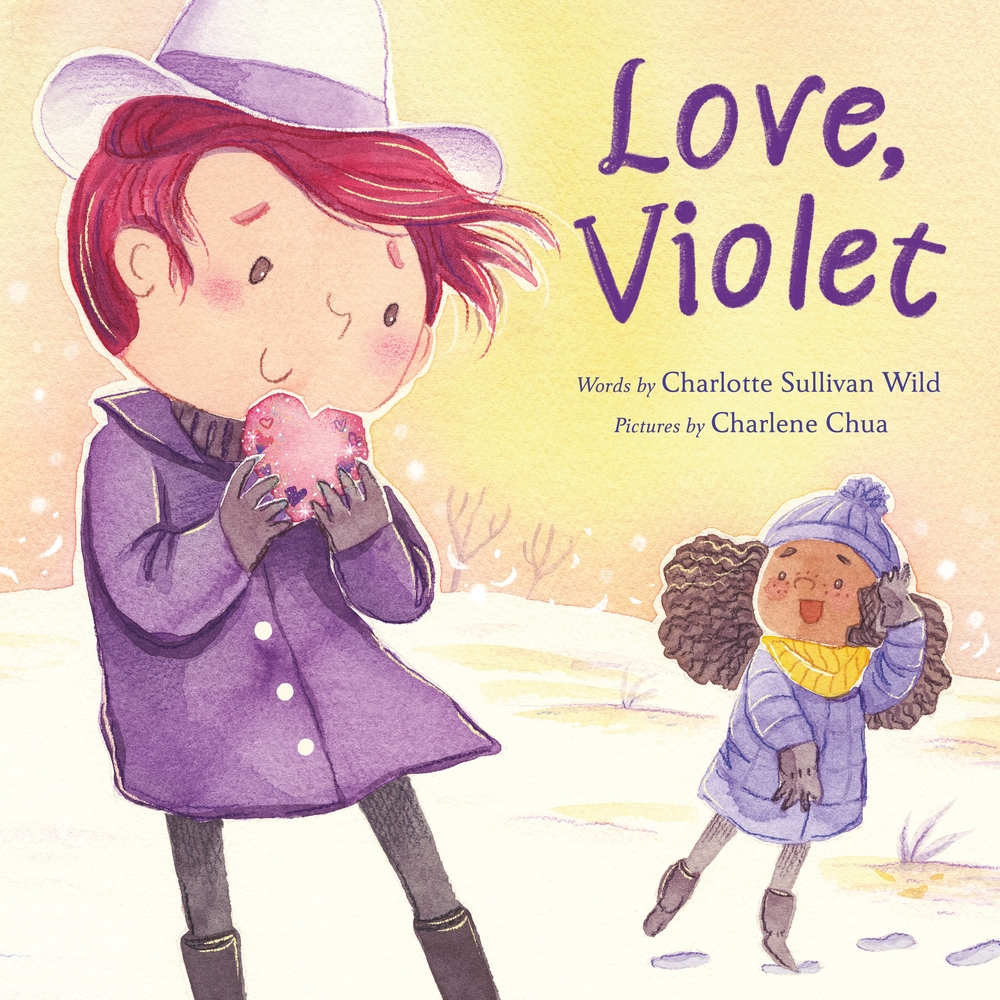
With winter winds howling, and some of us wading through snow, who couldn’t use a story about a sweet crush to warm us up? Releasing today (January 4, 2022), Charlotte Sullivan Wild’s picture book, LOVE, VIOLET, is just the ticket. Illustrated by Charlene Chua, and published by Farrar, Straus and Giroux, the book garnered stars from both Kirkus (“…earnest, awkward Violet is a protagonist every reader will root for,”) and Publishers Weekly, which called it an “uplifting wintry tale…a race through the snow―choreographically captured with dancelike grace in Chua’s simple, light-filled watercolors―brings the duo together at last, making the holiday one of joyful acceptance.”
Just in time for Valentine’s Day, Charlotte has stopped by to tell us more about the book and to offer a giveaway! (So stick around to the end for details.)
Charlotte, I am in love with the language of this book. Probably most people familiar with my books know I’m a sucker for alliteration, but you took it beyond that, writing sentences that simply sing, like this one: “Violet sank into the tangle of scarves.” Exciting word choices like that are no accident. Can you tell us about your history as a writer? Surely you must write poetry — or at least read a lot of it? Are you a many-drafts sort of writer, or does some of that beautiful language spill out in early drafts for you? (Sorry, that was cheating. That was a lot to tuck into one question!)
Thank you! Musical language does come naturally for me. But also? I revise. OBSESSIVELY. I wonder if I honed this skill during my school days acting and singing. Not just crafting words, but performing them. Running lines over and over, learning to pace my breath, control the tone, drive to the line to a focal point. I learned that very phrase, every piece has a shape. Motion and mood. Art is managing these elements in a way that sweeps away the audience. Isn’t that picture books, too?
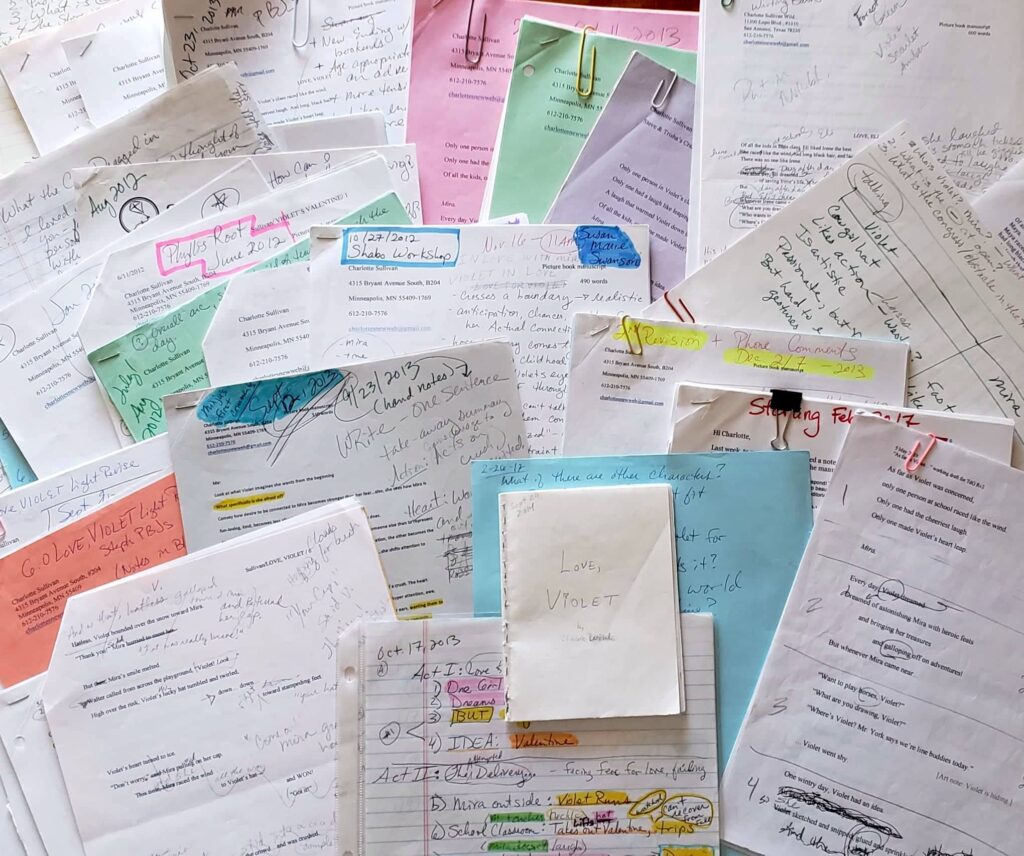
My choir teacher used to say, music is always moving toward or away from a point. Still water goes stagnant. Running water stays fresh, catches the eye. So, I’m always thinking about how the sounds and silences, the patterns and surprises are sweeping us through arcs of change in a text. It’s a journey. Even the sounds of the words themselves adjust tempo and tone as we travel. For singing, I focused on emotional tone, placement, and the breath. For picture books, it’s word sounds, rhythms, the page turns—and yes, planning the breaths. Regardless of the form, words are living things. To be performed! An experience of motion and emotion. After all, I’m writing for a performer and a live audience! [Kim interjecting here to say I am not surprised that Charlotte equates her word choices to rhythm and melody. Even her emails are lyrical!]
The language is the story’s body; it carries the meaning like a soul. The words must be the story. Feel like the story breathing, slinking, JOLTING! Or sighing… us softly… to sleep. When I revise, I ask, do these sounds in my mouth feel like the thing described? Can I read this easily? Where are the breaths? How can I help my reader? Yes, we write for the head and the heart, but also, for the ear and tongue. For the diaphragm (Gasp!), the cathedral of the throat (HA!). For the hair on the back of the neck. When the language sings, it is the harmonics of the story. It rings you like a bell.
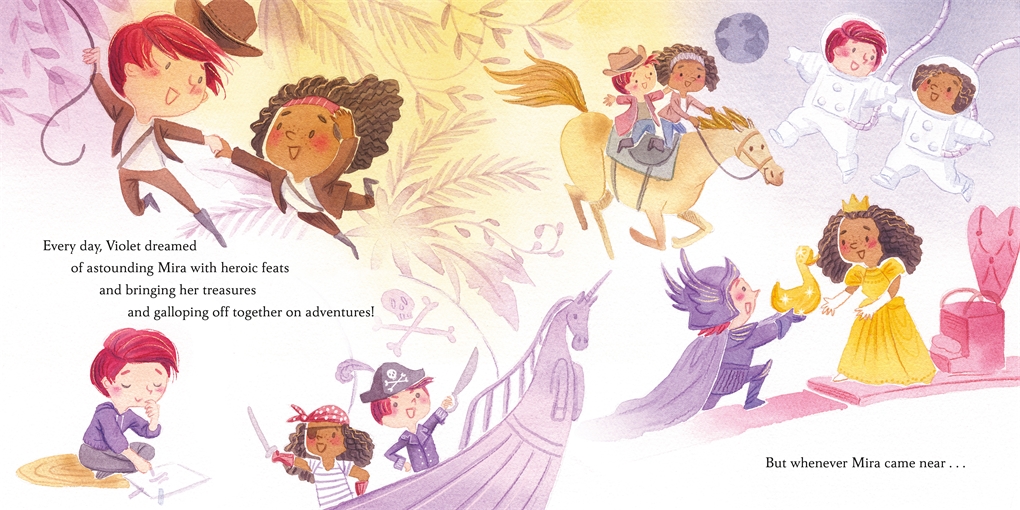
I love that you have written a story that such a wide swath of people will relate to. It’s not just a story about one girl having a crush on another girl. We have ALL had that wallflower panic, worrying whether we’ll be rejected. How much of little Violet’s life springs from your own experiences?
I always want to know this, too! The answer is tangly. And I wonder of sometimes people expect diverse fiction to be more autobiographical. Yet, fiction is that mystical braid of the personal, the observed, and the imagined. All fiction is autobiography. And all fiction is fabrication. It’s the mingling that sparks magic.
For Love, Violet, I did the strange dance many queer writers must do—to imagine what expressing myself would have been like. Because I couldn’t. Yet I could sprinkle throughout the story real feelings, real details from young crushes—mine, those of friends and kids I know. Going speechless? Making “special” valentines, the playground rescues, specific daydreams? These true bits glint throughout the granite of this fabrication. I hope that mingling feels both fantastical and True!
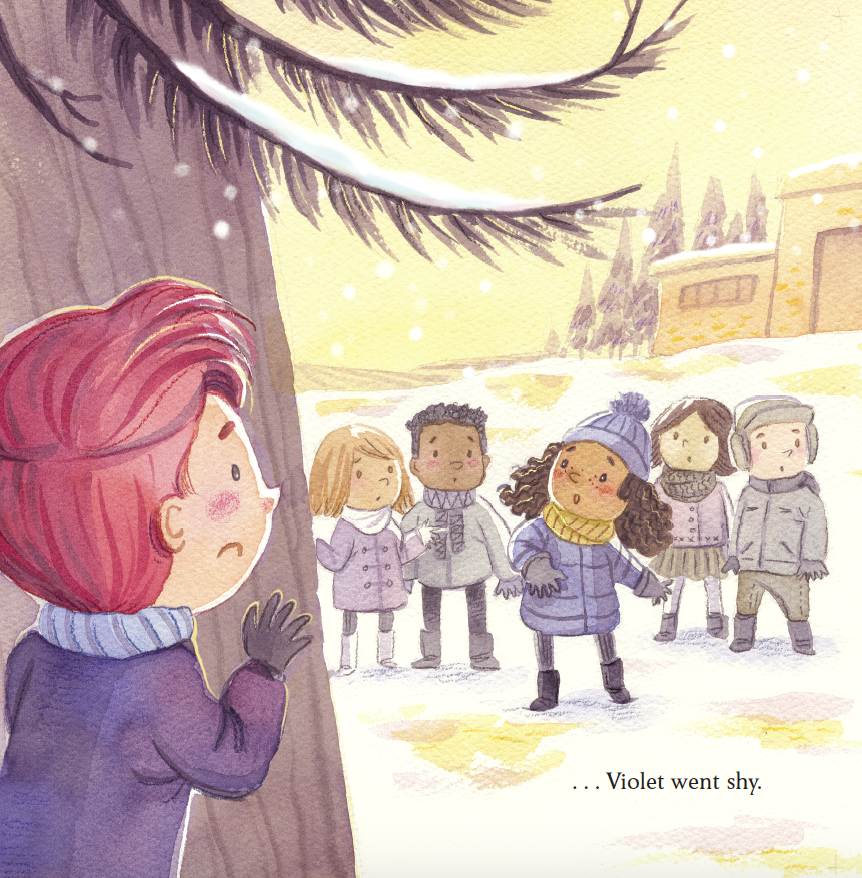
On the other hand, Love, Violet IS autobiographical, sideways. In early drafts, I STRUGGLED with Violet’s characterization. I knew her. I was in her skin in every scene (Enraptured! Terrified!) But when I attempted to translate her heart into words, I fumbled speechless. Like Violet does. Of course, I had three decades of practice smothering my feelings before I came out. That image of Violet cowering behind the tree? That’s how the closet feels. That’s why I wrote Love, Violet, so one day, no kid will feel that way. Ultimately, to bring Love, Violet OUT into the world, breaking silence became both my emotional task and Violet’s plot. Autobiography. Fiction.
But the best True thing about Love, Violet is the love itself—shown from inside to out. What do I mean? When I fell for my spouse, I soared! Snow swirled! The world glowed! (Yes, it was a winter romance!) Soon, we settled into our beautifully ordinary life. Loving her in harmony with my nature, even in the messy details, was beyond anything I’d imagined! That was “inside” love. But the moment we stepped “outside,” came the slap. Oh, right. We’re “queer.” Our personal love (good day or bad) was political. People argued about us. Could we hold hands? Had I called her hon? Was this a safe place? My wife’s career was at stake. That was the “outside” love. The world defining us, our love, as “other.”
I wrote Love, Violet from the “inside” because Love is the Big Story of my life. Yes, I came out first (SPLASH!) But then, I found my spouse! Now the drama of identity has faded. Love hasn’t. So, I wrote that. Even better, I gave Mira and Violet a world without fences between inside and outside. Acceptance is assumed. Labels don’t matter. Only people. And choices. And love most of all.
That’s pure autobiography.
And pure fiction.
And my hope in the form of fiction.
Charlene Chua’s illustrations are wonderful! How much do you love watching an illustrator bring your story to life?! I especially adore that first big reveal, seeing how an illustrator has “cast” my story. Sometimes it’s a surprise, and then it feels just soooo right. Like, of COURSE that’s what they look like. Do you feel the same way? (I seem to be using the word “love” a lot, but hey, I give myself a pass. It’s a Valentine’s Day book, after all!)
I’m swoony about Charlene Chua’s watercolors! They’re so warm and sweeping, with the just-right sense of new, topsy-turvy love! And winter magic!
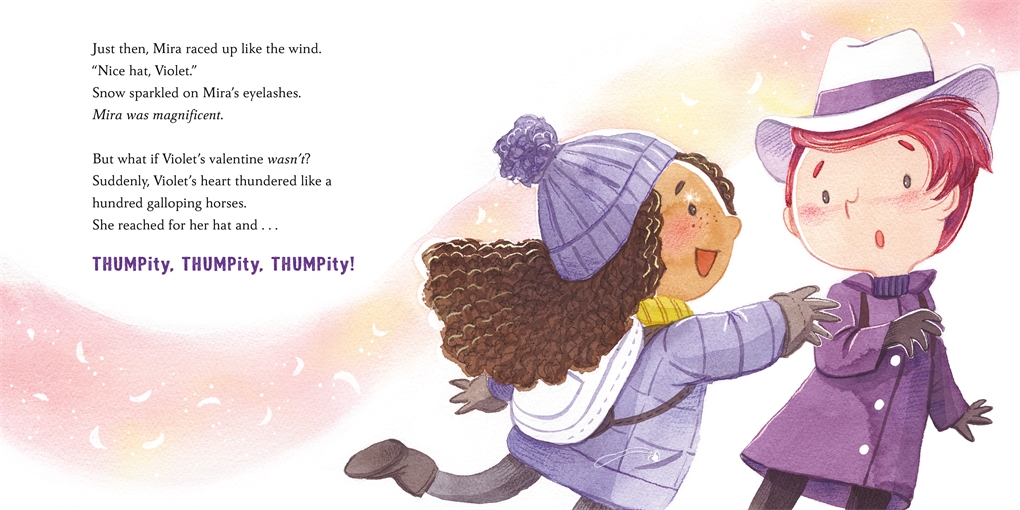
It’s always transporting to watch the art evolve. (Charlene and I dish about this process here.) The first time I saw Violet’s new short hair, I was speechless. (Joyfully!) To see Violet’s gender identity, so similar to people I love, people who never see themselves starring in a love story? And beautiful Mira, this vibrant, feminine girl of color, also the star—loving and beloved? TEARS OF JOY.
You made a video for young readers in which you and others convey the comforting message… well… I’ll quote you directly: “You are lovable, exactly the way you are.” I’m sure this is a message you longed to hear as a child. While it’s wonderful that publishers and other content creators are more willing to spotlight stories like this, I know there are people right now who will feel it’s their duty to “protect” their children from that kind of message. (I’m rolling my eyes at the word “protect.”) Do you think things are changing or have we stumbled back a bit… or does the fact that this book is being published mean the world is still a friendlier place for children who feel different now (no matter what the difference) than when you were Violet’s age?
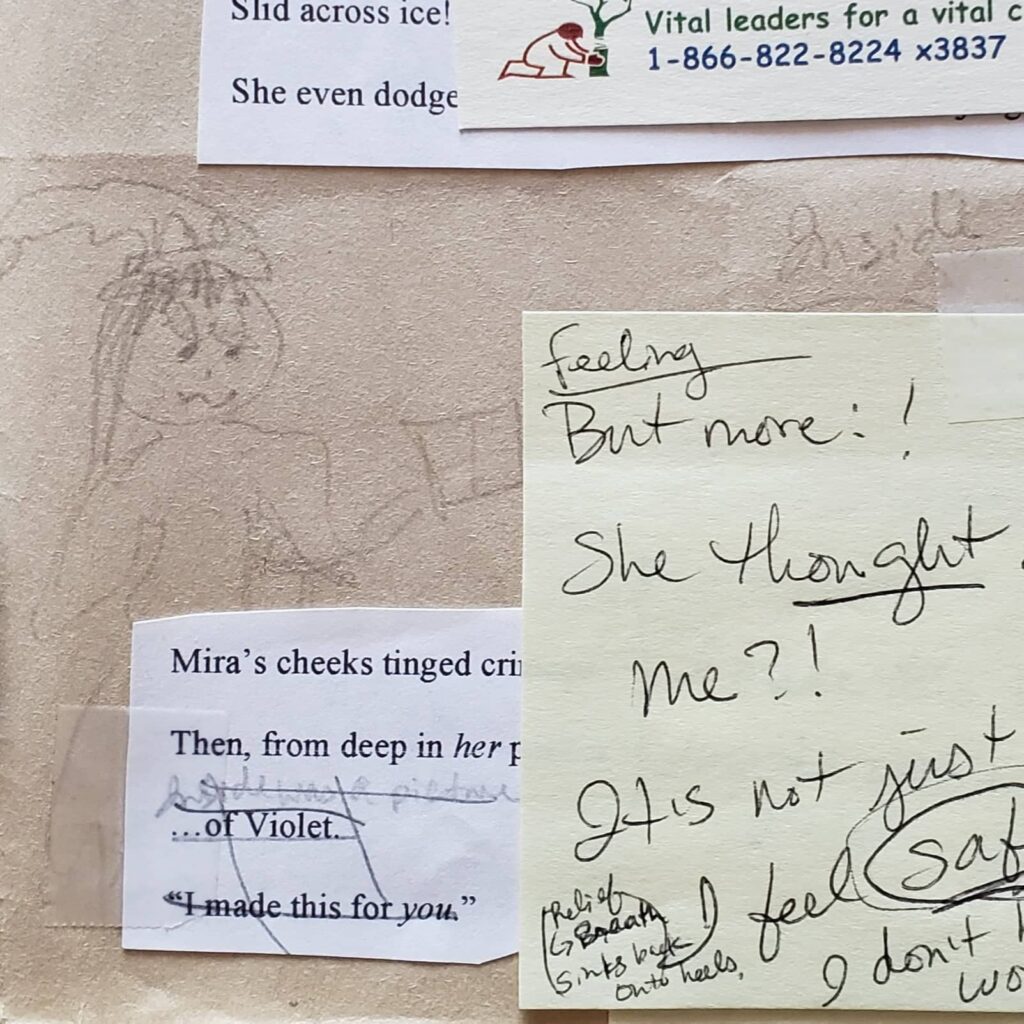
This moment—is so much. On one hand, we’re living through life-saving progress: LGBTQIAP2+ people are visible! That genie isn’t going back in the bottle. Even in unsafe places, kids at least know they are not alone. I’ve watched young ones express themselves with support, in ways I couldn’t have imagined at their age. And yes, after epochs of erasure, Love, Violet and so many quality diverse books are finally here! It feels miraculous!
On the other hand, visibility draws fire. That fire is organized, it’s mainstream, and it’s targeting kids. With bizarre laws and historic assaults on the freedom to read and learn, to even know about the lives of people of color, disabled or queer people. We have ALWAYS had erasure (I write about that here). But now? The bigotry is open. Bold. Like the not-so-good old days.
I struggled with this question because as GLSEN reports, harassment of queer kids at school has plummeted over the last two decades. Which is amazing! To even have rainbow safe spaces? And: in 2019, “86% of LGBTQ+ students were harassed or assaulted at school.” “Two in 5 LGBTQ+ students of color were bullied or harassed based on race or ethnicity.” One third of LGBTQ+ “students missed at least one entire day of school in the past month because they felt unsafe or uncomfortable.” This is chilling. Each number represents real kids. As has always been the case, how “safe” one is depends on which body, which family, which zip code you’re in.
But I have hope. Kids are standing up! In the past half century, have you seen a young generation this alert and active in the pursuit of justice? And now, a flood of diverse books is cutting through this storm’s roar like missives of love, right to kids’ hearts. Books like these and these. Organizations like We Need Diverse Books and Pride and Less Prejudice, and the American Library Association are laboring to get books into kids’ hands. As in every age, in the midst of ugliness, is goodness, too.
So, in this winter of strife comes Love, Violet like a valentine, a signal to every kid caught in an unsafe place: We are here. We support you. When you’re ready, you CAN find supportive community. There’s a reason queer folk often refer to each other as Family. Sometimes we aren’t welcome in our own. Sometimes neighborhoods feel like a war zone. Love, Violet is a gift for every soul who needs to hear: You are not alone. You are lovable. This joy?
Is for YOU.
What advice would you give to picture book writers and illustrators who have written or illustrated stories they suspect some people won’t want to hear?
This is such an important question. Diverse creators often find unique burdens placed on their work. It’s over-scrutinized. Judged not “universal.” Challenged over “authenticity.” (Must it be 100% autobiographical? Is there ONE way to “be an identity”? How do you write diverse fiction?) Sometimes only “correct” representations are allowed. (Who decides?) I experienced versions of all of this with Love, Violet. (More about that journey here.)
For example, two queer editors questioned why I would even write this story. Another praised Love, Violet (it reminded them of their young crushes!), but felt it was too niche to sell. An ally, rejected it because they felt the queer representation wasn’t casual enough. This pickiness baffled me given the total lack of representation of queer childhood then. And, Love, Violet IS casual representation. In a way, this direct resistance was easier to process. I simply had to persevere.
More unnerving was feedback blending craft and bias. I was unpublished, so it threw me into self-doubt. Maybe it was the writing? Maybe I didn’t remember childhood correctly? Did I KNOW what I KNEW? Even my agent admitted she’d never seen editorial feedback so all over the map. How do you revise? For example, were my characters realistic for their ages? (Important!) Or, were my readers unable to picture queer kids? Was my character’s personality inconsistent? This one really shook me until I realized the true question was: “Can a butch/ gender queer person be sentimental”? (Uh…Meet. My. Wife. And all my sappy butch friends!) The question came not from malice but stereotypes I was writing to dismantle. So, I had to dig into my own confidence and KNOW what I KNEW.
Anyone writing from under- or poorly represented experiences can expect questions about “believability,” “relatability,” and “likability.” (Malinda Lo’s blogging on this shines like a lighthouse over stormy seas.) Take such objections with oceans of salt. (Is it really unrealistic to have several queer characters in a story?) If you’re writing against the grain, against what has been seen, some feedback will derive from discomfort and misunderstanding. Sometimes, and this hurts, it’s from allies. Friends. In those moments, I remember my own blind spots. Yes, it stabs. Angers. But dwelling? Naw. Those biases? That’s why you’re writing.
I spent decades in the closet not knowing what I knew. When I busted out, the joy of liberation turned me BRAVE. Which is not the same as unafraid. That’s the way to approach work from the margins. KNOW what you KNOW. Lean into your emotional knowledge, believe your experiences. And absolutely learn from others to find your blind spots. Then set your sites on the kids you work for. Tell the stories only you can tell. The process will be messy no matter what, diverse or not. It might be messier if it is diverse, it the world is unresolved about your right to exist, to KNOW what you KNOW.
And that work may mean the most.
To those learning empathy.
Especially to those aching for the story only you can tell.
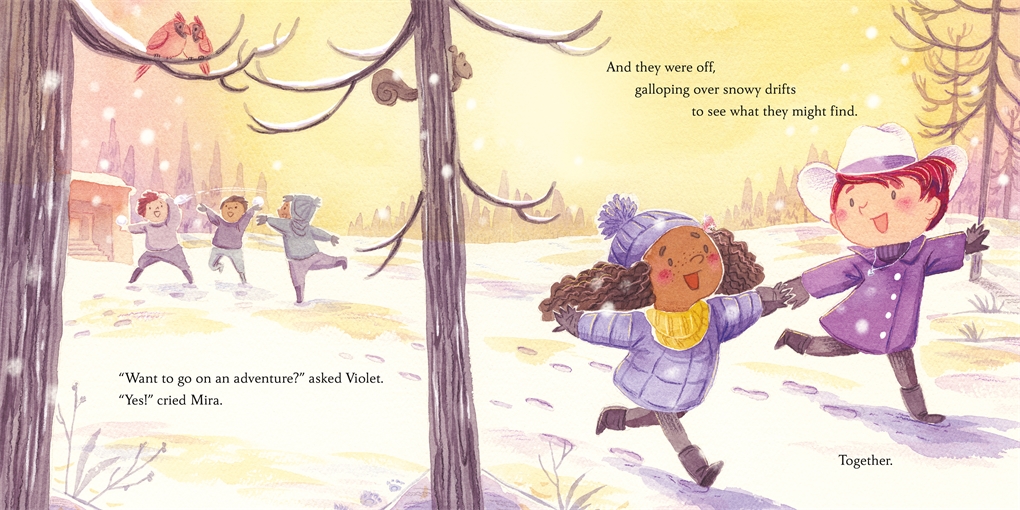
Thank you for stopping by, Charlotte! PBB readers, be sure to leave a comment for a chance to win a copy of LOVE, VIOLET in a random drawing we’ll be doing by February 1st, 2022. Happy (almost) Valentine’s Day, everybody!
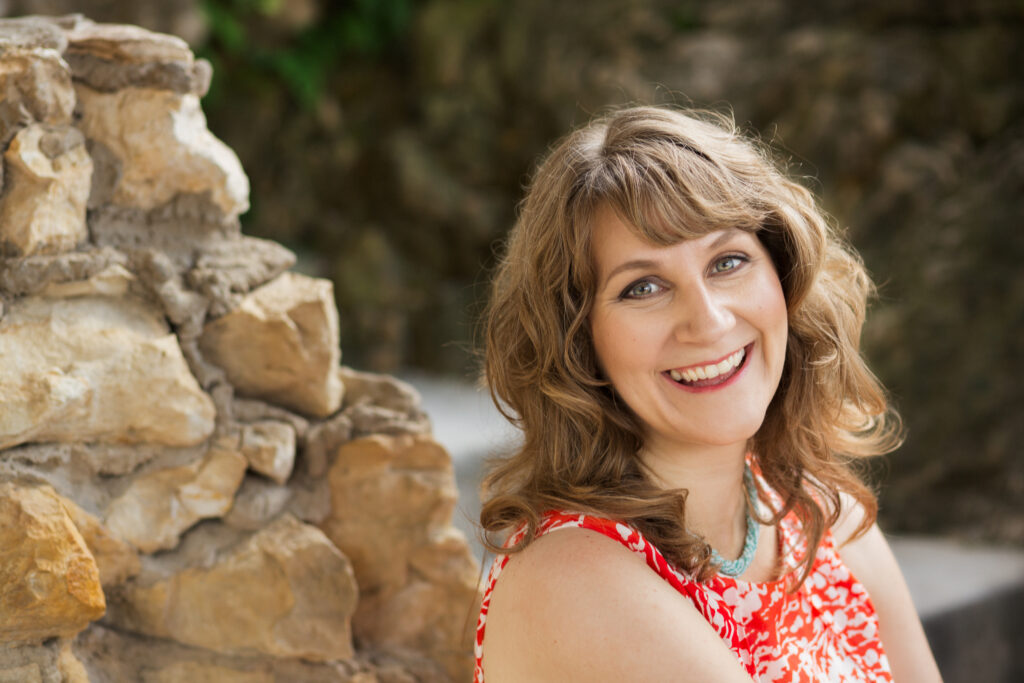
Charlotte Sullivan Wild was first struck speechless by a crush in preschool. In grade school she may have cut and pasted a special Valentine for someone and been too shy to sign it. But she’s not shy about love anymore! Her first picture book is The Amazing Idea of You, illustrated by Mary Lundquist. Originally from snowy Minnesota, she now lives wherever her wife is stationed, from Texas to Italy, to see what they might find―together.
Charlene Chua‘s debut picture book Hug? came out in September 2020. When she is not making art, she enjoys cooking, reading, and playing with her cats. She now lives with her husband (and cats!) in Hamilton, Ontario.

Oh my, oh m my y, oh my, this interview has left me breathless, so I can’t even imagine how the book will make me feel!
Isn’t Charlotte an amazing writer?! I felt the same way, reading her insightful answers to my questions.
What a great interview. I love soaring language in PBs that should be sung. Cannot wait to read this book!
I’ve been looking forward to this book, and I’d love to win a copy. Congrats, Charlotte and Charlene!
Taking a stand via a PB is brave and necessary.
What an insightful interview. Thanks for sharing!
I loved this interview and can’t wait to read LOVE, VIOLET.
Oh my. What a lovely book filled with warm feelings. Absolutely cannot wait to read and share!
Wow! Very inspirational interview. Bravo and congratulations on both the theme and wording !
A sweet, tender story. Congratulations!
I enjoyed reading about what this author thinks about when selecting words for her books. I am so happy this author also told her personal story to help others. I’m excited to read this book.
Best of luck with this story. It will touch many hearts.
This is so very wonderful!!!
What a perfect mentor text for the book I’m writing. I can’t wait to read it!
Oh, wow. Thanks! And best wishes for your story!
Congrats! This sweet story sounds like a winner.
Book looks great, thanks for posting!
A book I wish I had had growing up! Children are so much more in tune to their feelings than most adults realize. I can’t wait to own this book & add it to my daughter’s library <3
<3 The book is new, but this is the comment I'm hearing so much. Thank you for sharing this. And I agree. Kids are full, feeling humans. Best to you and your daughter!
Wonderful, thought-provoking interview! ALL writers can benefit from pondering Charlotte’s personal and creative journey, and heeding her wise words:
KNOW what you KNOW. Lean into your emotional knowledge, believe your experiences. And absolutely learn from others to find your blind spots. Then set your sights on the kids you work for.
Thanks, Kim, for bringing us this interview, and thanks Charlotte for the depth of your answers. Best of luck with this beautiful book that is full of heart, hope, and love!
Thank you! <3
I am so excited for this book!!! I ordered mine through Red Balloon and can’t wait to get my copy! Congratulations!
What a wonderful book! I’m so excited to read it!
“I spent decades in the closet not knowing what I knew.” Wow, this statement really resonated with me, as well as the sweet innocence and true emotions depicted in this story. Thank you for writing this important book, Charlotte, and hats off to Charlene for creating visualizations of these gorgeous and authentic characters! Can’t wait to read it.
Thank you! <3
Isn't Charlene's art GORGEOUS?!
The idea that there are diverse ways to be an identity really resonated with me. There is room for diverse story creators to tell many stories, in many ways.
Thanks everyone for such kind comments! <3
And for helping to get books like LOVE, VIOLET into the hands and hearts of little ones! That is EVERYTHING!
XOXO Charlotte
Fantastic interview! I am encouraged by Charlotte’s experience in seeing her beautiful book go through the publishing process. As a queer author at the beginning of that process I have already had feedback (from other queer authors and cis agents) questioning if I am the right kind of queer to write about a non-binary MC. But I know what I know—thanks for that phrase! I would love to win a copy of this gorgeous picture book!
<3
A very insightful interview. Thank you for sharing your journey of writing LOVE, VIOLET. My favorite line was: All fiction is autobiography. And all fiction is fabrication. It’s the mingling that sparks magic. So true!
This book looks incredible! I would love a copy, to share with my second grade students and my own kids!
Thank you so much for your work teaching and raising kids, something NOT easy ever, but especially now!
I have extra goodies for educators here: http://www.charlotteswild.com/books/love-violet/
(Scroll down to free printables and videos) and also under the Educators tab.
Also, if it’s of use, illustrator Charlene Chua and I have a full video presentation and story time. Don’t hesitate to reach out if there’s a way we can support your students!
Great news, Tessa! You’re the winner of the random drawing for Charlotte’s book! I’ll put you 2 in touch with each other so her publisher can get that book to you. Congratulations!
Congratulations Charlotte on the lovely book! I really enjoyed the post and also the picture of your story drafts! If I win the book I will get it posted to a school in the US.
Such a sweet and very important story! Congrats, Charlotte!
Thanks for the lovely interview. So inspiring!
Great questions, Kim! And Charlotte, your answers are as beautiful and meaningful as your writing. Congrats, on LOVE, VIOLET.
Thank you, dear Penny!
What a spectacular interview, Kim. Charlotte, I loved so many things you said but KNOW what you KNOW is sticking the hardest. Congratulations. I can’t wait to read LOVE, VIOLET.
<3
Pingback: Love, Violet Interview with Charlotte Sullivan Wild & Charlene Chua – Geeks OUT
Charlotte, I am so grateful to you for sharing about your process and for writing this book. I’m struggling for words… when I read about the pain of feedback that questions the story, your affirmation of the story and recognition that the feedback had hidden bias, your empathy and hope that the book will reduce bias, and declaration to kids that they are beloved just as they are…I feel like I have entered a holy space. A place of wholeness. I appreciate you!!!!